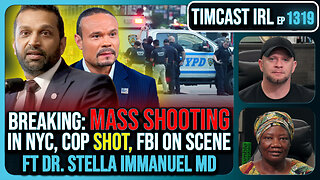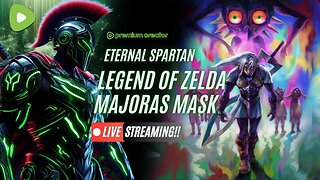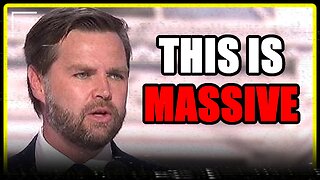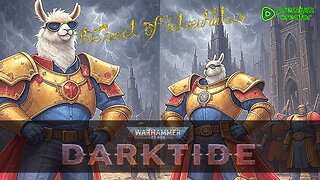Premium Only Content

Episode 2838: Word Made Flesh: Session 6: The Magi and Christmas Year-Round
Word Made Flesh: Session 6 (Finale): The Magi and Living the Spirit of Christmas Year-Round
Opening Prayer
“In the name of the Father, and of the Son, and of the Holy Ghost. Amen.
O Lord, who revealed the glory of Your Son to the nations through the Magi, grant us the grace to seek Him with the same devotion and to offer our lives in homage to His eternal kingship. May this discussion deepen our love for the mystery of the Epiphany and bring us closer to You. Amen.”
Some Admin Notes:
Feast of the Epiphany
In anticipation for the feast day of the Epiphany ("manifestation" or "appearance”) tomorrow, see the attached prayer for you and your family to recite together. Also don’t forget to pick up your epiphany chalk and holy water at your Church.
Epiphany Holy Water is more powerful than regular Holy Water due to the special blessing it receives during the liturgy of the Feast of the Epiphany. The ritual for blessing Epiphany Water is more elaborate and includes:
1. The Litany of the Saints: Invoking the intercession of the saints adds a spiritual depth.
2. Exorcisms: Both the water and salt are exorcized, explicitly driving away evil spirits.
3. Sacred Prayers: The prayers used invoke the manifestation of Christ at His baptism, emphasizing His divine authority over creation.
4. Triple Blessing: The priest often blesses the water in a triple sign of the cross, symbolizing the Holy Trinity.
Because of that, the elements make Epiphany Water revered for use in spiritual warfare, protection against evil, and blessings. So have it handy in your homes.
Liturgical Calander
Catholic Cowards
Part 1: The Magi
Timing of the Magi's Visit
Why the Tradition of Three Kings?
The Church Fathers, including Origen and St. Augustine, emphasized this symbolism. By connecting the gifts to Christ’s mission, the Church recognized that the Magi’s actions were prophetic and deeply theological.
Further, Sacred Tradition identifies the Magi as 3 kings to fulfill Old Testament prophecies, such as:
Isaiah 60:3: “Nations shall come to your light, and kings to the brightness of your rising.”
Psalm 72:10-11: “May the kings of Tarshish and of the isles bring tribute, the kings of Sheba and Seba offer gifts. May all kings bow before Him.” This is where the Church comes up with the 3 Kings.
The kingship of the Magi underscores the universal call to adore Christ, who is the King of Kings and Lord of Lords.
In a sermon 132 on the Epiphany of Christ, St Augustine explains: “Though many kings of the Jews had been born and died, none of them did the Magi seek to adore. And so they who came from a distant foreign land to a kingdom that was entirely strange to them, had no idea of showing such great homage to such a king as the Jews were wont to have. But they had learnt that such a King was born that by adoring Him they might be sure of obtaining from Him the salvation which is of God.”
Pope St Leo the Great writes, “they might seek with more ardent faith Him, whom both the brightness of the star and the authority of prophecy revealed.” (Sermon xxxiv) My personal addition is that Gentile kings were the first to bend their knees in homage while rulers and priests of Israel ignored Christ and then sought to kill Him.
St. Thomas Aquinas taught that the Magi were the first Gentiles to believe in Christ, and that the star that guided them was likely an angel:
Aquinas taught that the Magi were the "first-fruits of the Gentiles" to believe in Christ.
Aquinas believed that the star that guided the Magi to the newborn Christ was probably an angel, rather than an astrological conjunction of heavenly bodies. He also suggested that the star appeared to the Magi in a similar way to how the Holy Ghost appeared to Jesus in the form of a dove after his baptism.
The Names of the Magi
Catholic tradition, dating back to at least the 6th century, assigns the Magi specific names:
Melchior: Traditionally depicted as an older man with a white beard, Melchior offered gold, representing Christ’s royal status.
Caspar (or Gaspar): Often shown as a younger man, Caspar offered frankincense, signifying Christ’s divine nature and priestly role.
Balthazar: Portrayed as a man of darker complexion, Balthazar presented myrrh, symbolizing Christ’s mortality and His ultimate sacrifice on the Cross.
These names and descriptions not only personalize the Magi but also emphasize the universality of Christ’s kingship. By coming from different regions and representing varied ethnicities, they symbolize that salvation is for all nations and peoples. The Magi also represent or refer to the stages of human growth: Gaspar, youth, Balthazar, maturity and Melchior, old age.
The Significance of the Magi
1. Theological Importance
The Magi represent the first recognition of Christ by the Gentiles, fulfilling the prophecy that the Messiah would be a light to all nations (Isaiah 49:6). Their journey to Bethlehem demonstrates that Christ’s mission is universal, not limited to the Jewish people.
2. Their Gifts
Each gift holds profound spiritual meaning:
Gold: Offered to a king, gold acknowledges Christ as the rightful ruler of heaven and earth.
Frankincense: Used in worship, this gift honors Christ’s divinity, acknowledging Him as true God.
Myrrh: A burial ointment, myrrh foreshadows Christ’s Passion and death, highlighting the redemptive nature of His mission.
3. Their Faith and Obedience
The Magi followed the star with unwavering faith, journeying far from their homelands to honor the newborn King. After encountering Herod, they obeyed the divine warning to return home by a different route, signifying their allegiance to God over earthly powers.
Why This Matters Today
The story of the Magi continues to teach us:
The Call to Seek Christ: Like the Magi, we are called to seek Christ with determination and faith, even amidst challenges and uncertainties.
The Call to Offer Our Gifts: The Magi remind us to offer our talents, treasures, and lives to Christ, recognizing Him as our King.
The Call to Evangelize: By returning to their countries, the Magi likely shared the news of the Messiah, becoming the first evangelists to the Gentile world.
A Lesson from Sacred Tradition
Pope Benedict XVI, in his book Jesus of Nazareth: The Infancy Narratives, highlights the Magi as “wise men” who sought truth, illustrating that faith and reason are not opposed but complementary. Their journey reminds us that the pursuit of truth ultimately leads to God.
Who Were the Magi?
The term "Magi" comes from the Greek word magoi, which refers to wise men or scholars, particularly those skilled in astronomy, philosophy, and interpreting omens. These were men of great learning who sought knowledge of the divine and the cosmos.
Their Likely Background
Historically, the Magi were likely members of a priestly caste in the East, possibly from Persia (modern-day Iran), Mesopotamia (Iraq), or even Arabia. These regions were known for their advancements in astronomy and their study of celestial phenomena.
Persian Influence:
In Persian culture, the Magi were associated with Zoroastrianism, a monotheistic religion that emphasized the struggle between good and evil. Zoroastrian priests studied the stars for divine signs, making it plausible that these Magi could interpret the star of Bethlehem as a sign of a divine king’s birth.
Arabian Connection:
Early Christian tradition, particularly from the writings of St. Bede the Venerable, suggests that at least one of the Magi came from Arabia. This connection is reinforced by the gift of frankincense, a resin native to the Arabian Peninsula.
Babylonian and Jewish Influence:
Some scholars suggest the Magi might have been influenced by Jewish prophecies during the Babylonian Exile. The Book of Daniel mentions wise men in the Babylonian court, and the prophecy of a Messiah may have been preserved in these regions.
Geographical Origins of the Magi
Catholic tradition assigns specific regions to each of the Magi, emphasizing their representation of the known world and the universality of Christ’s mission.
Melchior
Region: Often associated with Persia.
Symbolism: Represents Asia and wisdom.
Gift: Gold, symbolizing Christ’s kingship.
Caspar (Gaspar)
Region: Typically linked to India or Arabia.
Symbolism: Represents youth and faith.
Gift: Frankincense, honoring Christ’s divinity.
Balthazar
Region: Associated with Africa, possibly Ethiopia.
Symbolism: Represents maturity and sacrifice.
Gift: Myrrh, foretelling Christ’s suffering and death.
This tradition of assigning distinct origins to each Magus reflects the fulfillment of Psalm 72:10-11: “May the kings of Tarshish and of the isles bring tribute; may the kings of Sheba and Seba offer gifts. May all kings bow down before Him, all nations serve Him.”
What Happened to the Three Kings?
1. Their Conversion and Baptism
Catholic tradition holds that the Three Kings—Melchior, Caspar, and Balthazar—returned to their homelands after worshiping the Christ Child. There, they are said to have shared the Good News of the Messiah's birth. According to a legend recounted in the writings of St. Bede the Venerable, the Magi were later baptized by St. Thomas the Apostle when he traveled to the East to evangelize.
Spiritual Transformation: The encounter with the Christ Child profoundly changed them, leading them to become Christians and preach the Gospel in their regions.
Apostolic Witness: This tradition connects the Magi to the spread of Christianity in Asia and Africa, emphasizing the universality of Christ's mission.
2. Their Deaths as Saints
The Magi are believed to have died in their respective homelands, remaining faithful to Christ. Over time, they were venerated as saints, and their relics became a focus of devotion.
Relics of the Magi:
According to tradition, the relics of the Magi were discovered by St. Helena, the mother of Emperor Constantine, during her pilgrimage to the Holy Land in the 4th century. These relics were later moved to Constantinople and then to Milan before finally being transferred to the Cathedral of Cologne, Germany, in the 12th century. They are enshrined in a magnificent reliquary in the Cologne Cathedral, which has become a major pilgrimage site.
Symbolism of Their Lives and Deaths
The Church views the Magi as models of faith, obedience, and perseverance. Their post-Nativity lives symbolize the following:
Evangelization: They remind us of the call to proclaim Christ to all nations, regardless of personal cost.
Sacrificial Witness: Their departure from worldly riches to follow Christ exemplifies detachment from earthly treasures.
Faithful Perseverance: Their conversion and fidelity until death underscore the importance of lifelong commitment to the faith.
Liturgical and Devotional Significance
The Three Kings are honored particularly during the Feast of the Epiphany (January 6), which celebrates the manifestation of Christ to the Gentiles. In many Catholic traditions, the Magi are also invoked as intercessors:
Patrons of Travelers: Their long journey to Bethlehem makes them patrons of those who travel in search of truth and salvation.
Role Models for Converts: The Magi’s spiritual journey is seen as a model for those converting to the Catholic faith.
What was the travel time by foot at the time the 3 kings traveled
The travel time of the Magi to Bethlehem would have depended on their point of origin, the terrain, and the challenges of travel in the ancient world. While Scripture does not specify where the Magi came from, traditional sources suggest they traveled from regions such as Persia (modern-day Iran), Babylon (modern-day Iraq), or Arabia. Below is an analysis based on these possibilities.
Estimated Travel Times by Foot or Caravan
1. From Persia (Modern-Day Iran)
Distance: Approximately 1,000–1,200 miles (1,600–1,900 km) to Bethlehem.
Travel Time:
By Foot: 3–4 months, assuming 15–20 miles per day.
By Caravan: Likely similar or slightly faster due to sustained travel but with breaks for rest and supplies.
2. From Babylon (Modern-Day Iraq)
Distance: Approximately 500–600 miles (800–960 km).
Travel Time:
By Foot: 1–2 months, depending on weather and terrain.
By Caravan: 6–8 weeks.
3. From Arabia
Distance: Approximately 500–700 miles (800–1,120 km), depending on the specific location.
Travel Time:
By Foot: 1–2 months.
By Caravan: 4–6 weeks.
So the 3 Kings could have been in Bethlehem within a 2-month period if they traveled by Caravan which is most likely what they did.
St Augustine believed that the date of the Epiphany, Jan 6th, proved that the Magi reached Bethlehem 13 days after the Nativity.
Factors Influencing Travel Time
Mode of Travel:
The Magi likely traveled in a caravan, which was safer and more efficient, especially for wealthy travelers carrying precious gifts. Camels or pack animals would have been used to carry supplies and enhance mobility.
Terrain and Weather:
The journey would have included desert plains, mountains, and river crossings. Extreme weather whether hot desert days or cold nights—could slow progress.
Political and Social Barriers:
Ancient trade routes were often controlled by local authorities or bandits. The Magi may have had to navigate through checkpoints or pay for safe passage.
Astronomical Observation:
The Magi likely used celestial signs to guide their route, traveling mainly at night when the star was visible. This could have slowed their pace.
Why the Journey Took So Long
In the Gospel of Matthew, King Herod orders the massacre of children two years old and under (Matthew 2:16), suggesting that the Magi might have set out on their journey close to the time of Christ's birth. This timeframe aligns with the significant travel distances and the time required to organize such a journey.
Spiritual Reflection
The lengthy and arduous journey of the Magi underscores their perseverance and devotion. Traveling for months across difficult terrain shows their unwavering faith and determination to worship the Christ Child. Their story inspires us to pursue Christ with the same dedication, regardless of obstacles.
Do they have a date on when the star would have appeared?
The exact date of the appearance of the Star of Bethlehem has been a subject of debate among scholars, historians, and astronomers. While the Bible does not provide specific dates, the Gospel of Matthew (Matthew 2:1-12) indicates that the star led the Magi to the birthplace of Jesus. Based on historical, astronomical, and theological insights, several theories propose possible dates for the star’s appearance.
Theories About the Timing of the Star
1. Historical Context:
Jesus was likely born between 6 and 4 B.C., based on historical evidence such as the death of King Herod, which occurred around 4 B.C.
The star would have appeared either shortly before or at the time of Jesus’ birth, marking the beginning of the Magi's journey.
2. Astronomical Theories:
Scholars have studied celestial phenomena that might align with the description of the star in Matthew’s Gospel.
Planetary Conjunctions:
A rare conjunction of Jupiter and Saturn occurred in 7 B.C. in the constellation of Pisces. This event would have been significant to astrologers of the time.
A conjunction of Jupiter and Venus in 3 B.C. created a bright "star-like" appearance in the night sky.
Comets or Novae:
The Chinese recorded a bright comet or nova in 5 B.C., visible for over 70 days.
Comets were often interpreted as omens of significant events and could match the description of the star leading the Magi.
Supernova Hypothesis:
Some have suggested that a supernova a massive explosion of a star might explain the star’s brightness and duration. However, no recorded supernova from that period matches the timeline.
Date Speculations Based on the Magi’s Journey
If the Magi began their journey upon observing the star, the star likely appeared 1–2 years before they reached Bethlehem, as suggested by Herod’s order to kill all male children two years old and under (Matthew 2:16). This would place the appearance of the star around 6–5 B.C.
Theological Reflection
The Church does not define the Star of Bethlehem as a purely astronomical event. It is often seen as a miraculous sign, fulfilling the prophecy of Numbers 24:17:
“A star shall rise out of Jacob, and a scepter shall come forth from Israel.”
St. Thomas Aquinas suggested that the star was a unique phenomenon created by God for the specific purpose of guiding the Magi. This view allows for both natural and supernatural interpretations.
The Desert Fathers, early Christian monks and hermits who lived in the deserts of Egypt and the surrounding regions, generally did not focus specifically on the Magi in their writings. Their teachings primarily emphasized spiritual discipline, asceticism, and the pursuit of holiness. However, certain Church Fathers and early Christian writers contemporary to or influencing the Desert Fathers did address the Magi, providing interpretations that influenced later tradition.
Key Insights from the Church Fathers on the Magi
1. Origen (185–254 AD):
Origen, an early theologian, provided one of the first traditional interpretations of the Magi. He identified them as three kings, based on Psalm 72:10-11:
"May the kings of Tarshish and of the isles render him tribute; may the kings of Sheba and Seba bring gifts!"
Origen linked the gifts of gold, frankincense, and myrrh to their royal status and to Christ’s kingship, divinity, and humanity.
2. St. John Chrysostom (347–407 AD):
St. John Chrysostom emphasized the spiritual significance of the Magi as representatives of the Gentiles. He wrote that their journey symbolized the fulfillment of Isaiah's prophecy (Isaiah 60:1-6) about nations coming to the light of Christ. He viewed the star as miraculous and divinely orchestrated rather than a natural phenomenon, underscoring its role as a sign of God’s providence.
3. St. Augustine (354–430 AD):
St. Augustine interpreted the Magi's journey as a demonstration of faith and the universality of salvation. He noted how their recognition of Christ's kingship contrasted with the Jewish leaders’ rejection, symbolizing the opening of the covenant to all nations. Augustine also reflected on the gifts:
Gold: Offered to Christ as King.
Frankincense: Acknowledgment of His divinity.
Myrrh: Foreshadowing His death and burial.
Connections to the Desert Fathers’ Spiritual Themes
While the Desert Fathers did not explicitly write about the Magi, the story of the Wise Men aligns with their spiritual priorities:
Detachment from Earthly Wealth: The Magi’s willingness to leave their homes and offer costly gifts mirrors the ascetic ideal of renouncing worldly possessions for the sake of Christ.
Seeking God in the Silence: The Magi’s journey across vast and desolate lands reflects the Desert Fathers’ understanding of spiritual journeys through physical and interior deserts to encounter God.
Faith in Divine Guidance: The Magi followed the star without full knowledge of where it would lead, a trust in God’s providence that resonates with the Desert Fathers’ emphasis on obedience and surrender to God’s will.
Later Reflection Influenced by the Fathers
The teachings of early Church Fathers like Origen, Chrysostom, and Augustine shaped the Church's understanding of the Magi, influencing how their story was preserved in Catholic tradition. Their insights helped establish the theological symbolism of the Magi's gifts, their journey, and their role in salvation history.
Conclusion on the Magi: While the Desert Fathers themselves did not directly expound on the Magi, their story aligns with the Desert Fathers' values of detachment, spiritual seeking, and trust in divine providence, making it a complementary narrative within the broader tradition of the Church.
Part 2: Carrying the Spirit of Christmas into Everyday Life
Theme: Becoming Imitators of Christ
The celebration of Christmas, centered on the mystery of the Incarnation, offers us profound insights into God’s love and humility. As St. Paul teaches in Colossians 3:1-17, Seeking Heavenly Realities
“Set your minds on things that are above, not on things that are on earth. For you have died, and your life is hidden with Christ in God.” — Colossians 3:2-3
St. Paul’s exhortation is a call to transcend the distractions of earthly life and align our focus with the eternal. This isn’t a rejection of our earthly responsibilities but an invitation to approach them with heaven as our ultimate goal.
The saints understood this perspective deeply. St. Therese of Lisieux once said, “The world’s thy ship and not thy home.” Earthly life is a journey, and heaven is the destination. How often do we allow fleeting pleasures or anxieties to obscure this reality?
What steps can we take daily to shift our focus from temporary concerns to eternal truths?
Putting to Death Earthly Vices
“Put to death therefore what is earthly in you: sexual immorality, impurity, passion, evil desire, and covetousness, which is idolatry.” — Colossians 3:5
Paul’s language is direct and urgent: to live in Christ requires the death of sin within us. This transformation isn’t merely about avoiding certain behaviors but rooting out the attachments that lead us away from God.
St. Augustine, reflecting on his own journey from sin to holiness, wrote: “You have made us for Yourself, O Lord, and our hearts are restless until they rest in You.” Restlessness often drives us to seek fulfillment in earthly things, but true peace is found only in Christ.
What earthly attachments might be hindering your spiritual growth? How can sacramental Confession and prayer help in putting them to death?
Embracing Virtues of the Christian Life
“Put on then, as God’s chosen ones, holy and beloved, compassionate hearts, kindness, humility, meekness, and patience.” — Colossians 3:12
“Above all these put on love, which binds everything together in perfect harmony.” — Colossians 3:14
Having stripped away sin, St. Paul urges us to “put on” Christ-like virtues. These virtues compassion, kindness, humility—are not optional but essential for living as new creations in Christ. They transform us into living witnesses of God’s love.
St. Francis de Sales taught, “Nothing is so strong as gentleness, nothing so gentle as real strength.” These virtues require strength, but they also create harmony in our lives and communities.
How can we cultivate these virtues in our families, workplaces, and parishes?
Worship as the Center of Virtue
“Let the word of Christ dwell in you richly, teaching and admonishing one another in all wisdom, singing psalms and hymns and spiritual songs, with thankfulness in your hearts to God.” — Colossians 3:16
St. Paul highlights that our virtues flow from worship. The Mass, where we encounter Christ in Word and Sacrament, nourishes and equips us to live the Christian life.
St. John Vianney once said, “If we really understood the Mass, we would die of joy.” The Eucharist is the source and summit of our faith, empowering us to set our minds on heaven, die to sin, and live virtuously.________________________________________
Practical Application: Traditus Program
A. Making a Spiritual Growth Plan for the Year
1. Daily Practices:
o Begin the day by offering it to God through the Morning Offering.
o End the day with an examination of conscience and gratitude for Christ’s presence.
o Incorporate brief but meaningful prayers, such as the Angelus or a decade of the Rosary, into your routine.
2. Weekly Commitments:
o Attend Sunday Mass with greater reverence and preparation.
o Spend time in Eucharistic Adoration to meditate on the mystery of the Incarnation.
o Dedicate time to serving others, whether by helping a family member or volunteering at a parish ministry.
3. Monthly Goals:
o Participate in the Sacrament of Reconciliation to deepen your relationship with Christ.
o Choose a specific virtue to focus on cultivating each month (e.g., January: humility, February: charity).
B. Identifying a Saint to Model
• Saints embody Christ’s virtues and provide tangible examples of holy living. Consider these saints:
o St. Francis of Assisi: For his radical humility and love for the poor.
o St. Therese of Lisieux: For her commitment to doing small things with great love.
o St. Joseph: For his quiet obedience, steadfastness, and protection of the Holy Family.
• Study the life of your chosen saint and seek their intercession daily.
4. Prayer
Evening Prayer Practice
1. Reflect on your day:
o Where did I see Christ present in my life today?
o How did I imitate Him in my actions? Where did I fall short?
2. Thank God for the gift of the Pascal Mystery.
3. Ask for the strength to grow in virtue tomorrow.
Conclusion
The Incarnation is the cornerstone of our faith, calling us to continuous conversion and imitation of Christ. By carrying the spirit of Christmas into our daily lives, cultivating virtues, and following saintly examples, we allow the mystery of the Word made flesh to transform us. Let us strive to make the reality of Christ’s presence visible to the world through our words and deeds, living out His humility and love e
Closing Prayer
“O Holy Magi, chosen by God to honor His Son with your gifts and adoration, pray for us that we may always seek Christ with humility and courage. Teach us to offer our hearts and lives to Him as you offered your gifts. May we, like you, proclaim His glory to all we meet. Through the intercession of the Blessed Virgin Mary and St. Joseph, may we grow in faith, hope, and charity. Amen.”
-
 2:51:11
2:51:11
TimcastIRL
6 hours agoBREAKING: MASS SHOOTING ERUPTS In NYC, Police Officer SHOT, FBI On Scene | Timcast IRL
252K103 -
 LIVE
LIVE
ZWOGs
13 hours ago🔴LIVE IN 1440p! - EFT w/ crgoodw1n, Kingdom Come Deliverance, Splitgate 2, & More! - Come Hang Out!
1,529 watching -
 30:09
30:09
Afshin Rattansi's Going Underground
1 day agoCurtis Yarvin: ‘Trump 47 is 10x More Powerful than Trump 45’ & the TOXIC US-Israel Relationship
29.4K34 -
 3:48:08
3:48:08
Drew Hernandez
10 hours agoTRUMP HINTS DEMS COULD HAVE PLANTED FAKE EVIDENCE & MANIPULATED EPSTEIN FILES
54.6K32 -
 LIVE
LIVE
Eternal_Spartan
13 hours agoThe Legend of Zelda: Majoras Mask Ep. 5 | USMC Vet | Come Join the Best Chat on Rumble!!!!
83 watching -
 3:44:24
3:44:24
Barry Cunningham
8 hours agoBREAKING NEWS: LIVE COVERAGE OF NEW YORK POLICE OFFICERS UNDER SIEGE!
99.1K70 -
 2:51:25
2:51:25
The Pascal Show
5 hours ago $2.01 earnedBREAKING! Active Shooter In Midtown Manhattan NYC Multiple People Shot!
25.2K4 -
 10:25
10:25
MattMorseTV
10 hours ago $11.36 earnedVance just DROPPED a NUKE.
47.3K45 -
 5:05:09
5:05:09
Jokeuhl Gaming and Chat
8 hours agoDARKTIDE - Warhammer 40k w/ Nubes and AoA
22.5K2 -
 2:53:08
2:53:08
Shoriantrax
4 hours agoLIVE: Hardcore Chaos in Tarkov – Loot, Die, Repeat!
13.5K